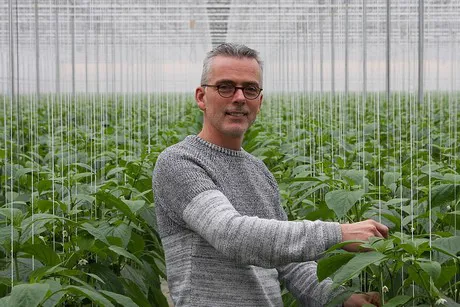Pepper grower Hans van der Waal in Zevenhuizen red and yellow peppers on an acreage of 8.3 hectares. In November, the crop rotation took place in the first year that the individual purification requirement was in effect. That is why the grower aimed for drier slabs before the end of the cultivation, so that all the water from both the dirty and clean drainage silos had been fully used. As a result, no discharge into the sewer was needed.
Contaminated drain water
At the start of the new cultivation season, the new stone wool slabs are first dripped full with clean water (0 EC). For the draining of the slab, a cut is made at both ends of the stone wool bags. The released drain water then runs through the cultivation gutter and takes along remnants of roots and cleaning agents from the crop rotation. That water ends up in the dirty drainage silo.
Van der Waal: "Approximately a quarter of the volume of water that we have used for dripping full of the slabs has returned as first flush (first drain water). Because we want to grow on a clean basis, we do not keep that drain water with contaminated substances, some 200 cubic meters, in the cultivation system. Before discharging it into the sewer, the cleaning products are removed first by the treatment plant. "For the spraying clean of the greenhouse, the grower has used Eco-Forte, a cleaning agent based on modified hydrochloric acid and without hydrogen fluoride.
Stop discharge
After fully draining the slab, the pepper plants were placed on it the next day. After that also the dripping with 3.5 EC was started again. Because the plants do not absorb so much water in the beginning, there is a lot of drain water that ends up in the dirty drainage silo. "We wanted to reuse the drain water as quickly as possible. But we had to wait a couple of days, necessary for the purification and discharge of the first flush into the sewer," says the pepper grower.
The treatment plant has a capacity of 1.5 m3 / hour. That is why it took more than five days before all the contaminated water from the dirty drainage silo was treated and discharged. "Before the water is treated by the purifier, it first goes over a cloth filter. Once all root residue had been removed, we knew we could stop the discharging."
A lot of condensation water
In cold weather a lot of condensation water is generated. Van der Waal: "It is nice clean water to reuse again. However, it may not be stored in the rainwater basin, but must be transported to the dirty drainage silo, because it contains residues of plant protection products. Because the plants absorb little water in the winter, the silos quickly fill up with a lot of condensation water. Before the silos start to overrun, we still have to discharge that good and purified irrigation water into the sewer. That is really a waste of this usable water. We would like to save it as purified water in the rainwater basin."
From the beginning of the cultivation, the pepper grower applies stabilized hydrogen peroxide. This is done in order to reuse the drain water as quickly as possible, keep it clean and prevent contamination. The application also prevents contamination of the drip hoses.
Not without purification
Because of the first contaminated drain water after the crop rotation and the condensation water in winter, the pepper grower cannot do without the purification plant. "The cultivation is still leading ahead of us. Some growers use a nail only to pierce a hole in the slab and let the plants absorb the water. We want the remove the first flush from the cultivation gutters and start clean. In our case we cannot do that without the purification plant."
A third reason for the purification is sodium. In a dry summer, like last year, the sodium content can become high. Van der Waal: "In a normal summer the sodium does not rise too high, as long as the starting water is good. We have already increased the limit for sodium content from 6 to 8 mmol per liter. But in spite of that, because of a long drought period, when using a lot of osmosis water with 0.4 mmol sodium per liter, the sodium content can still rise too high and purified discharge is necessary to prevent sodium accumulation in the slab."
Source: Glastuinbouw Waterproof (Harry Stijger)
